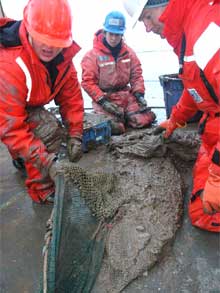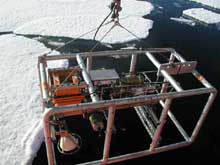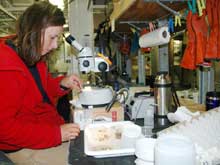
The Beam Trawl is back on board with a muddy load! The mud has to be sieved before the creatures within it will be found, identified and analyzed. Click image for larger view.
Scientist Bodil Bluhm looks at the benthic treasures brought up by the beam trawl under a microscope. Click image for larger view.
Muddy Jewels and Images of the Deep
July 7, 2005
Bodil Bluhm
Research Assistant Professor
School of Fisheries and Ocean Sciences
University of Alaska
Ian MacDonald
Professor of Environmental Science
Texas A&M University
Corpus Christi
Who lives deep down at the bottom of the Canada Basin? How can we find out? Researchers investigating the seafloor have used many different tools to obtain samples from the deep ocean floor around the world. To learn more about these creatures living in the deep, we use a variety of tools including a benthic trawl to collect the animals, and an underwater camera system to estimate their abundance and distribution.
Deploying a benthic trawl net in an ice-covered ocean, however, is not simple. First we need an open stretch of ocean with little to no ice cover- a rare occurrence on our route! So far, we have had two opportunities to deploy our beam trawl net, a mini-version of a commercial fish trawl with a metal beam across the opening. The first deployment did not go well. The trawl was lowered into the water just before the ship's propeller wash pushed an ice floe between the cable and the ship, lifting the trawl rig out of the water and dragging it across the ice! Once we were finally able to get the rig back on board we inspected the net to learn it had been torn in a few areas. We were disappointed, but not discouraged - and waited for the next opportunity.
The next opportunity came a week later at station 6: The navigation team on the bridge found a 4 mile long lead of open water on the most recent satellite images of the ice. The rear deck was filled with people when the trawl went in. Curious tension filled the fantail when the trawl was scheduled to come up on deck after many hours … did we lose it; did it catch anything and, if so, what?
The net was full of soft, sticky deep-sea mud, hiding its treasures inside. After 2 hours of sieving, we picked out our little jewels: Several 3 cm long, white sea cucumbers called Elpidia; a handful of small pale anemones; some clams, crustaceans and a number of yet unidentified creatures. Now we had collected some real specimens, some which would have to be sent to other experts for identification. Catching specimens of seafloor animals for identification and analysis is important, but seeing where and how they live is another important part of our study. The ROV gives us spectacular video footage from some areas, but now we have moved beyond the depths where it can operate. To see what lives in over 3,850 meters of water, we have assembled a photographic platform that can perform down to depths of 6000 meters.

The photo platform is deployed over icy waters. The platform could be used to take images of the seafloor down to 6000 meters deep! Click image for larger view.
The photo-platform is built to carry a camera in an underwater housing along with a big, powerful flash for lighting. The camera is pre-programmed to take images at time intervals of 10-20 sec using a time-lapse circuit. It uses powerful batteries, essentially two golf-cart batteries in an oil-filled container, to run the system. While in operation, a conductivity, temperature and depth sensor sends real time information about its depth and altitude off the bottom, as well as data on the water temperature, salinity, etc.
Unlike an ROV, there is no way to see the pictures taken by the photo platform until it returns to the ship. To take good pictures the platform needs to be no more than 5 m off the bottom, but if you get too close, your risk getting mud on the camera lens, or worse, damaging the system. Station 6 was particularly tricky because our altimeter (instrument telling us our altitude off the bottom) was acting up. Whenever the platform got to about 8 meters off the bottom, the altimeter would cut out.
Operating the camera quickly became nerve-wracking as we had no way of know if the platform was a safe 5 meters off the bottom. Our nervous anticipation increased as we brought the platform out, waiting to see if the pictures had come out. No sooner was the platform back on board than I took the camera and downloaded its images. Despite the difficulties, everything had worked out well- we collected 266 well-exposed images of the bottom that clearly showed bivalves, sea cucumbers, and anemones. Living animals were rarer than their trials, fecal coils, and burrows. There is life at the bottom of the Arctic deep-sea!
Using the photo platform to image the deep-sea fauna while concurrently taking trawl samples confirmed the species composition of the area sampled, and our success! After seeing the images collected by the platform we were thrilled with the trawl results: The cucumbers, anemones and other creatures collected seemed to be those that we had seen on the images taken by the photographic platform and the ROV. Best of all, our gear seems to be working, promising more jewels and images to come.
Sign up for the Ocean Explorer E-mail Update List.

































